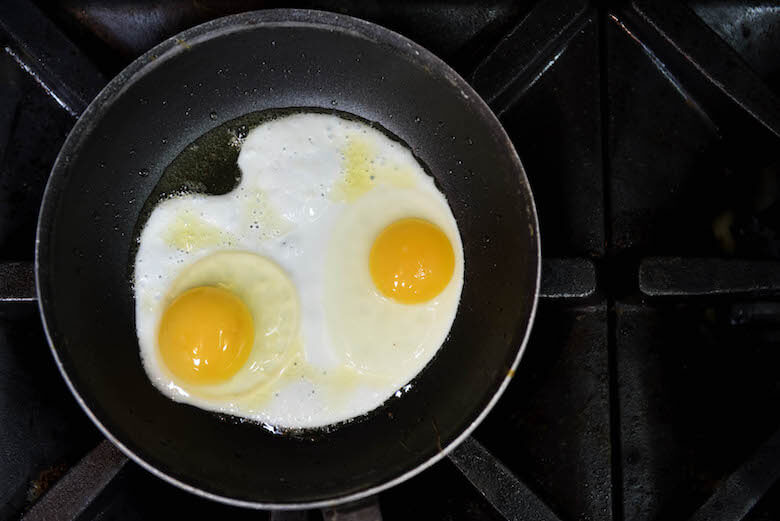
It was the end of March in Hiroshima and all thoughts of snow should have been long past. But there we were, winding up through the mountains in a minivan, huge clots of snow tumbling through the air and streaking the road in slick, slushy gouts. A child’s toy—the kind of thing you dangle over a cradle to keep a baby distracted—bounced lightly off my temple with every sharp curve; it was a comforting annoyance, I thought. He’s not going to drive us off the side of the road if he’s got a baby to get home to.
We were on the way to Hayashi Natural Farm to meet a flock of chickens. Less than a year ago, the head of a Japanese restaurant group had almost accidentally stumbled into Egg in Williamsburg and had fallen in love with the restaurant. He reached out to a friend who lived in Brooklyn, who then got in touch with me. We’d actually already thought that it would be smart and exciting to open an Egg in Tokyo (is there anywhere on earth more in love with food and more committed to making it great?), but we hadn’t had the first clue about how to pursue it, so the dream remained an idle fantasy. But a few months of meetings, visits and hopeless Japanese lessons later, here we were, meeting the chickens who’d be laying the eggs for our soon-to-open international outpost.
I’d flown down with Natsuko Hirao, my liaison with our Japanese team, from Tokyo, which swelled with signs of spring. We’d brought nothing but windbreakers to warm us against this late blast of winter. Farmer Hayashi Kentaro was apologetic about the weather and offered us umbrellas when he picked us up. Already green with spring, the surrounding tiny mountain farm towns disappeared under a sodden blanket of snow. There was something very familiar about them: The farms were a hodgepodge of old traditional houses and newish tractors, improvised storage sheds, drying racks and workshops. Substitute rolled tin roofs for ceramic kawara tiles and add a second story to these wide, graceful homes and you could be in rural Virginia or upstate New York.
The challenges farmers face there seemed familiar, too, as we learned from Kentaro’s parents who we visited before we went to see the chickens. We sat for an hour in a tatami-floored room, my long white legs going numb beneath me as we knelt by a table graced with tea, homemade mochi (dyed pink with radish juice for cherry blossom season) and custards made with eggs from said resident chickens. As in the States, farms in Japan had been under pressure to standardize, mechanize and cut costs to assimilate to a global commodity agriculture system. Even a farm as established as Hayashi—which had been under this family’s cultivation for nearly 100 years, cut out of wilderness and shaped over generations—even this farm was under that pressure. When Kentaro’s parents reached retirement age and their son was working a corporate sales job, they weren’t sure what was going to happen to their land.

But as happens (all too rarely) in the U.S., this farm was still plugging along thanks to Kentaro’s decision to return and focus on the farm’s strengths, differentiating it from commodity farms. Rather than try to crank out more eggs for industrial distribution, he emphasized the quality of the eggs he was gathering and highlighted the importance of good husbandry. They grew the rice that the chickens ate for feed, fermenting it with okara (the nutrient-rich by-product of tofu-making) to ensure the chickens ate well. In fact the food those chickens ate smelled so good that it made me hungry (that has never happened to me in an American chicken barn).
Standing there—my fingers numb and curled with the cold, a chicken in my arms—was one of the few times in the two months I spent opening the new restaurant half way around the world that I felt anchored. It was one of the few times I felt more at home than adrift. There were other moments to be sure—the familiar despair of a broiler going down in the middle of service, for example; the regular chatter of our chefs (Evan Hanczor from New York, Takuya Nishina from Tokyo) calling out orders in muted Japanese, or frantically riding a flat-tired bike around town one Sunday morning looking for enough decent brioche to hold us until our daily bread order came.

But this moment was the best of them: It was when the decision to open a restaurant in Tokyo felt like it would be more than just a thrill for me and our New York staff; it felt important, useful and like a chance to make a difference in a country where small farmers are struggling in the same way they do in the States. To be supporting someone like Hayashi, whose passion for what he did was so palpable, whose affection for his family and for what the generations before him had built was so strong that it pulled him back from the city and its promise of easy money—that’s what we’ve spent the last 13 years trying to do at Egg in Williamsburg.
The day after our visit, Natsuko asked me whether I had any concerns about Hayashi, and I had only one: What happens if this small farm can’t keep up with the number of eggs we need? She looked at me, surprised. “But that’s exactly what he hopes. Then he can grow the farm.”
SaveSave













